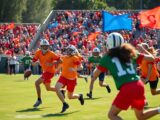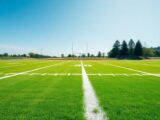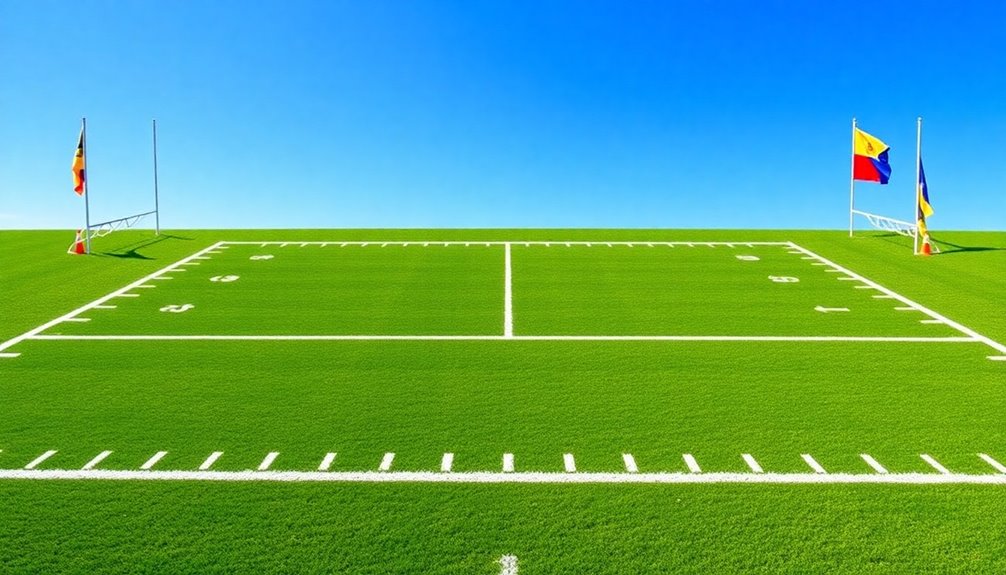
Flag Football Field Dimensions and Layout Tips
January 16, 2025To set up a flag football field, keep the dimensions standard at 30 yards wide and 70 yards long, with 10-yard deep end zones. For youth divisions, adjust widths and lengths accordingly. Mark yard lines every 5 yards and establish no-running zones at 5 yards before the goal line to enhance safety. Make sure to maintain at least a 3-yard safety area beyond the field boundaries, avoiding tripping hazards. Proper markings and organization will aid players in executing plays effectively. Stay tuned to discover additional strategies for an engaging playing experience.
Understanding Field Dimensions
When it comes to understanding flag football field dimensions, it's essential to know that a standard field measures 30 yards wide and 70 yards long, including two 10-yard end zones. This setup provides a total playing area of 2,100 square yards—ample space for your team to run plays and maneuver. Additionally, knowing the structure of matches(regulation time) in other sports can help in planning game strategies effectively.
One important aspect of these field dimensions is the no-running zones, which are marked 5 yards before each goal line. In these areas, only passing plays are allowed, promoting strategy and teamwork. Furthermore, understanding the concept of stoppage time can enhance your strategic approach during tight games.
Additionally, to guarantee player safety, it's recommended that fields have a safety area of at least 3 yards outside the sidelines and end lines.
When marking your field, remember that line markings should be 4 inches wide and must be flat and securely fixed to the ground for both visibility and safety. Understanding the dimensions of any playing field, including soccer field dimensions, is critical for creating a safe and effective environment for your games. With this knowledge, you can guarantee your flag football experience is organized and enjoyable for everyone involved.
Standard Flag Football Field Size
A standard flag football field measures 30 yards wide and 70 yards long, including two 10-yard end zones. Additionally, understanding proper soccer field dimensions can enhance your overall knowledge of sports field layouts. The field dimension rules are essential for creating a balanced playing environment. You'll also need to account for a safety area of at least 3 yards outside the sidelines and end lines to guarantee player safety during games. Understanding these dimensions helps you set up a safe and compliant playing environment for everyone involved, which is crucial for ensuring an enjoyable support experience during matches.
Standard Field Measurements
Standard flag football fields are designed with specific dimensions to create a balanced playing environment. A standard field measures 30 yards wide and 70 yards long, which includes two 10-yard end zones. This setup results in a total area of approximately 2,100 square yards, providing ample space for players to engage in the game.
The end zones, which are vital for scoring, are typically 10 yards deep on each end of the field. To guarantee fair play, the field must have clear markings for no-running zones, usually designated 5 yards before each goal line. These markings help players understand where they can and can't run, promoting safety and strategy.
Proper field dimensions are fundamental for creating a competitive atmosphere for players of all ages and skill levels. By adhering to these standard measurements, you can help guarantee that everyone enjoys a fair and engaging experience on the field.
When setting up or participating in a game, remember that these field dimensions contribute greatly to the overall enjoyment and safety of flag football.
Safety Area Requirements
To guarantee safety during flag football games, the field must include a designated safety area that extends at least 3 yards beyond the side and end lines. This guarantees players have enough space to safely navigate and avoid collisions.
The total area for a standard flag football field, including this safety zone, typically measures 76 yards long by 31 yards wide.
It's essential that the safety area remains level with the field surface to prevent tripping hazards and guarantee smooth movement for all players. Additionally, maintaining a minimum distance of 6 yards between adjacent flag football fields helps avoid unintentional collisions during play.
To further enhance safety, make certain to clearly mark no-running zones within the safety area, typically positioned 5 yards before each goal line. This guideline helps players understand where they can and can't run, reducing the risk of injury as they approach scoring opportunities.
Youth Flag Football Field Variations
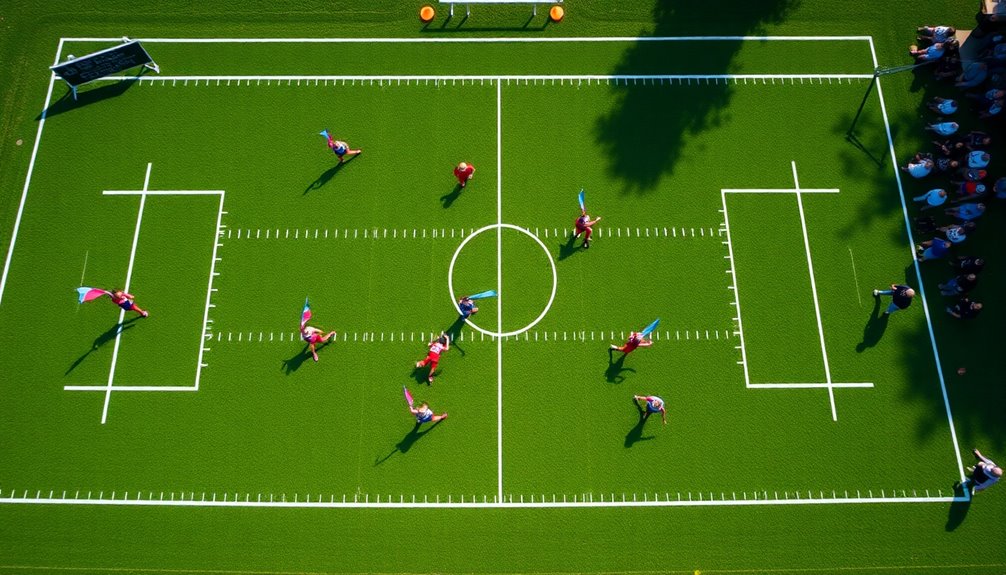
When it comes to youth flag football, field dimensions can vary considerably based on age groups and league regulations.
For the youngest players, like those in the 6U division, you'll find fields measuring around 25 yards wide and 50 yards long. This smaller playing area helps them grasp the basics without feeling overwhelmed, similar to how early soccer formats were designed to introduce children to the game. The concept of smaller playing areas in sports aids in skill acquisition and confidence-building among young athletes.
As players progress to the 8U and 10U divisions, the fields expand to dimensions of 30 to 50 yards wide and 50 to 80 yards long. This added space allows for more complex plays and skill development, fostering a better understanding of the game.
For the 12U players, fields are typically set at 50 yards wide and can reach up to 100 yards long, featuring 10-yard end zones. These dimensions align closely with standard youth league formats, providing a more competitive environment. Understanding player roles is crucial for developing teamwork and strategy on the field.
Each league may also implement specific rules regarding safety areas and no-running zones, which emphasizes the importance of clear field markings.
Ultimately, understanding these variations in field dimensions guarantees that you create a safe and enjoyable playing area for all youth athletes involved.
Importance of Field Markings
Proper field markings are vital for guaranteeing a smooth and safe flag football game. They help define the playing area and guide players throughout the match. Without clear markings, confusion can arise, impacting gameplay and safety.
Here are some key aspects of field markings you should consider:
- Yard Lines: Marked every 5 yards, they aid players and officials in tracking progress. Additionally, ensuring proper spacing among players can help maintain organized gameplay. The placement of yard lines can significantly influence team strategies during the game.
- No-Running Zones: Dashed lines indicate areas where only pass plays are allowed, maintaining a strategic flow.
- Goal Lines: Clearly marked to signify the end zones, these are vital for scoring plays.
- Safety Areas: Extend 3 yards outside the sidelines and end lines, guaranteeing a buffer zone for everyone involved.
These field markings not only enhance the game's clarity but also prioritize safety for players and spectators. Additionally, maintaining competitive balance is crucial in sports, as it ensures fair play and engagement among teams.
By implementing these guidelines, you'll create a more organized environment that allows everyone to focus on their performance.
Always remember, proper field markings are integral to the experience, so take the time to verify they're accurately laid out before the game begins!
Goal Post Specifications
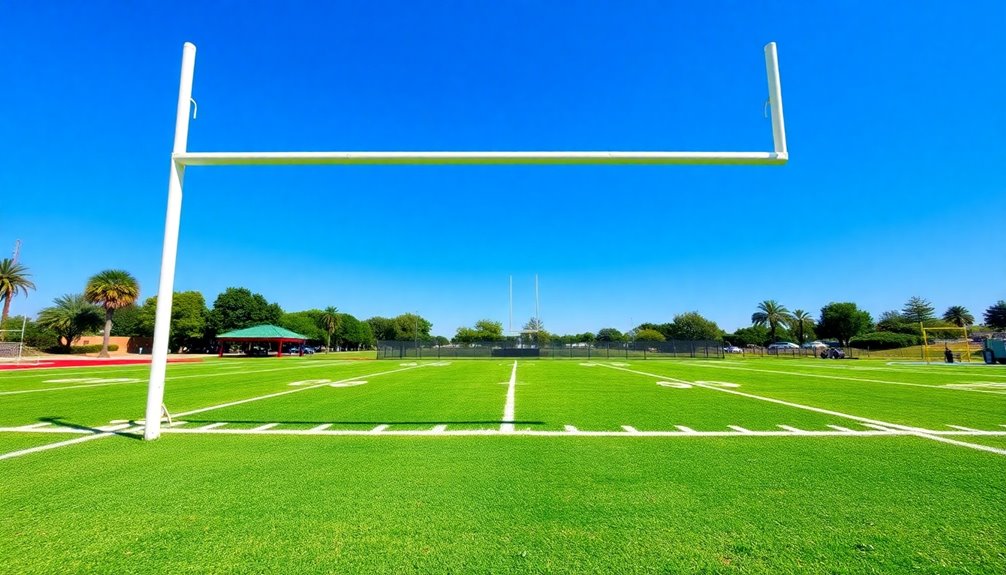
When setting up your flag football field, you'll want to pay close attention to the goal post specifications.
The standard height for the crossbar is 10 feet, but youth leagues often adjust this for younger players with shorter posts. Additionally, the goal post width is consistently 24 feet, ensuring a uniform scoring area across different levels of play. Understanding throw-in rules can also help in organizing team strategies during gameplay. Properly marking the field dimensions is important for game flow, as it ensures that all plays are executed within the intended boundaries. Ensuring that all players are aware of proper positioning can also enhance overall game performance and safety.
Goal Post Height Standardization
Goal post specifications play an essential role in guaranteeing a consistent and fair playing environment in flag football. The standard height for the crossbar is set at 10 feet, which helps maintain uniformity across all levels of play.
To further guarantee fair conditions, the height of the side posts varies based on the league; for example:
- NFL and NCAA standards require a height of 25 feet.
- High school fields may have post heights ranging from 12 to 15 feet.
- The distance between the goal posts is consistently 18 feet 6 inches.
- Proper installation is essential for safety and regulatory compliance.
These specifications are vital during scoring attempts, as they enable accurate measurement of field goals. With the right height and distance, players can focus on their strategy without worrying about inconsistencies.
Goal Post Width Variations
Understanding goal post width variations is essential for players and coaches alike, as these dimensions impact kicking strategies and scoring opportunities in flag football. In high school football, the goal post width is set at 23 feet 4 inches, while NFL goal posts are narrower at 18 feet 6 inches. This difference can greatly influence how you approach field goals and extra points during games.
If you're involved in youth football leagues, you might notice even more variations in goal post specifications, adapting to the smaller dimensions of their fields. This flexibility allows younger players to develop their skills in a more manageable environment.
As a player or coach, understanding these goal post width differences can help you tailor your strategies based on the league you're competing in. For instance, if you're preparing for a game with narrower posts, you might want to emphasize accuracy during practice sessions to adjust your kicking techniques accordingly.
Ultimately, being aware of these variations guarantees you're ready for any situation that arises on the field, enhancing your team's performance and increasing your chances of scoring successfully.
Safety Considerations for Layout
A safe flag football field layout is essential for protecting players and guaranteeing an enjoyable experience. To achieve this, you need to take into account several key factors when designing your playing field.
- Guarantee a safety area of at least 3 yards outside the side and end lines to prevent players from colliding with spectators or obstacles.
- Mark no-running zones clearly with disc markers or dashed lines at 5 yards before each goal line and midfield to minimize collisions during passing plays.
- Use flat, securely fixed line markings to avoid tripping hazards on the playing surface, maintaining a line width of 4 inches.
- Designate a minimum distance of 6 yards between adjacent fields to prevent interference and guarantee players' safety during games.
Additionally, regularly inspect the field surface for debris and uneven areas. This maintenance helps maintain a safe environment for everyone involved and greatly reduces injury risks.
Recommended Playing Surface
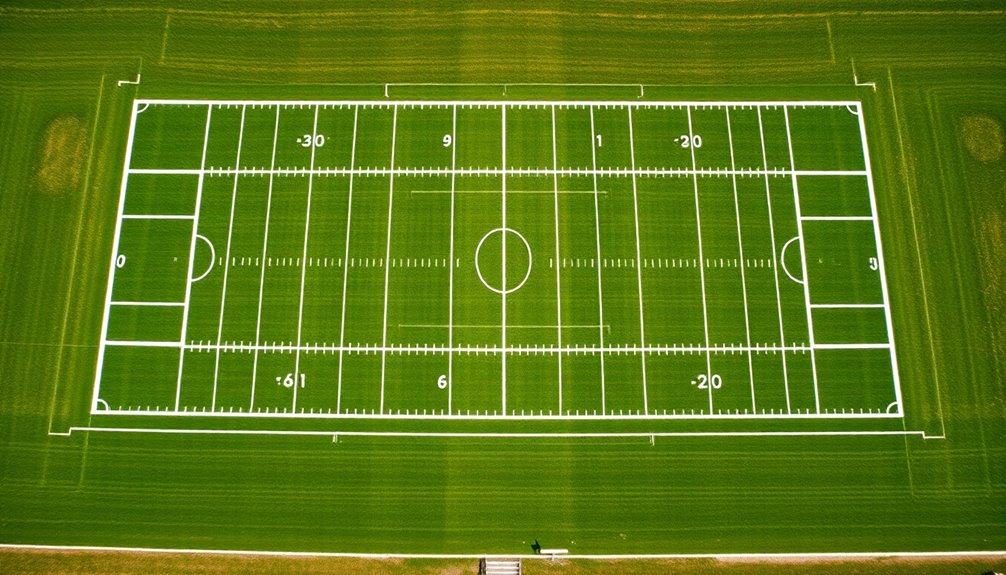
Creating a safe flag football field layout goes hand in hand with choosing the right playing surface. For most flag football games, your best options are grass or artificial turf.
If you opt for grass, make certain it's well-maintained, ideally at a height of 1.5 to 2 inches. This height provides a smooth playing surface and helps prevent injuries during gameplay.
If you choose artificial turf, be certain it's installed with appropriate infill materials that provide cushioning. This cushioning is vital for reducing the risk of injuries as players tackle the field.
No matter which surface you select, always check that it's free of debris, holes, or other hazards—these can compromise player safety and diminish the overall playing experience.
If you're considering a beach flag football game, sand is the recommended surface. It should be compacted but not too solid, allowing for safe movement and play.
Ultimately, whichever surface you select, prioritizing player safety will enhance everyone's enjoyment of the game. So, take the time to choose wisely, and your flag football games will be both fun and safe!
Field Layout Tips
When setting up your flag football field, pay close attention to proper field markings and equipment placement to guarantee clear visibility and effective gameplay.
Don't forget to include safety area considerations, maintaining a buffer zone around the field for player safety.
These layout tips will help create a better playing environment for everyone involved.
Proper Field Markings
Proper field markings are essential for ensuring a smooth game of flag football. When setting up your field, you'll want to pay attention to key aspects that enhance gameplay and safety.
Here are some important elements to evaluate:
- Field Sizes: A standard flag football field measures 30 yards wide and 70 yards long, with two 10-yard end zones.
- Yard Lines: Mark yard lines every 5 yards using a 4-inch wide line to make them clearly visible.
- No-Running Zones: Use dashed lines to indicate no-running zones, typically set 5 yards from each goal line and midfield.
- Pylons: Place pylons at the intersections of the sidelines and goal lines to clearly mark the corners of the end zones.
Make sure all markings are flat and securely fixed to prevent any tripping hazards during gameplay.
Equipment Placement Guidelines
To guarantee an organized and efficient gameplay experience, it's important to focus on equipment placement alongside field markings. Start by ensuring that your field of play has a minimum safety area of 3 yards outside the side and end lines. This buffer protects both players and officials during the game.
Next, position pylons at the intersections of the sidelines and goal lines to clearly mark the end zones. This helps players understand the boundaries they must respect. Additionally, place a down indicator 2 yards outside the sideline opposite the main stands. This equipment allows players and officials to easily track the current down.
For enforcing passing plays, clearly mark no-running zones using disc markers or dashed lines. Place these zones 5 yards before each goal line and at midfield for easy recognition.
Finally, install a 7-yard chain 2 yards outside the sideline near the main stands. This piece of football equipment is essential for measuring distances and keeping the game flowing smoothly.
Safety Area Considerations
Creating a safe playing environment starts with a well-defined safety area surrounding the field. This area is essential for ensuring players have space to maneuver and minimizing the risk of injuries.
To create an effective safety area, consider these key points:
- Maintain a minimum safety area of 3 yards (2.75 m) outside the side lines and end lines.
- Ensure the safety area is level with the field to avoid tripping hazards and keep gameplay consistent.
- Keep a minimum distance of 6 yards (5.50 m) between adjacent fields to prevent interference during games.
- Clearly mark the safety area using cones or painted lines to distinguish it from the playing field, enhancing visibility for players and officials.
Regularly inspect the safety area to make sure it remains clear of obstacles and hazards.
This diligence promotes a safe environment for all participants, allowing everyone to focus on the game without worrying about potential dangers.
Equipment Needed for Setup
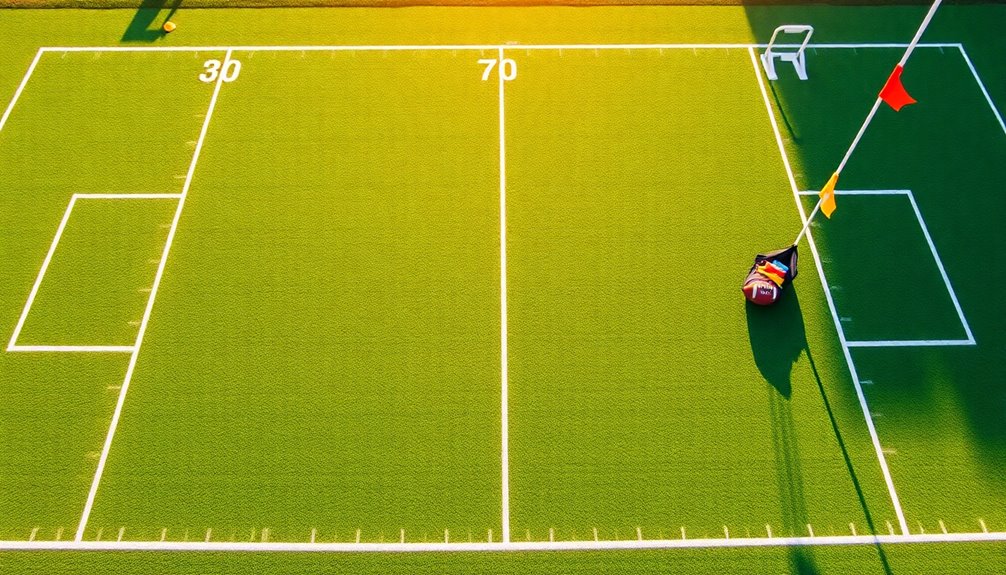
Setting up a flag football field requires essential equipment to guarantee an organized and safe playing environment. First, you'll need boundary markers to outline the field clearly, along with pylons for the end zones and goal line indicators to define scoring areas. These components help assure everyone understands the field's layout.
Next, a 7-yard chain is vital for indicating the line of scrimmage and measuring the distance for first downs; position it 2 yards outside the sideline for ideal visibility. For field markings, use a minimum line width of 4 inches to enhance visibility, and mark no-running zones with dashed lines or disc markers.
To maintain player safety, confirm the safety areas extend 3 yards outside the side and end lines, creating secure boundaries.
You might also want to include a scoreboard and a countdown game clock positioned outside the safety area, which are invaluable for tracking game progress and time.
With this equipment in place, you'll have a well-organized setup that promotes a smooth and enjoyable flag football experience for everyone involved.
Common Field Design Mistakes
When setting up a flag football field, you can't afford to overlook the importance of correct measurements and clear markings.
If your field isn't the standard size or if the yard lines are hard to see, it'll create confusion and frustration during games.
Making these common design mistakes can seriously impact player safety and the overall experience.
Incorrect Field Measurements
Properly measuring a flag football field is essential for ensuring fair play and enhancing the overall experience.
When you make mistakes in field dimensions and lines, it can disrupt gameplay and create confusion among players. Here are some common field measurement errors to watch out for:
- Ignoring the standard size: NFL flag leagues require a field of 30×70 yards, including 10-yard end zones. Not adhering to this can impact scoring plays.
- Misplacing no-running zones: These should be set 5 yards before each goal line. Incorrect placements can lead to inconsistent enforcement of rules.
- Neglecting safety areas: You need at least 3 yards outside the sidelines for player safety. Overlooking this can pose risks during games.
- Insufficient distance between fields: Maintain at least 6 yards between adjacent fields to prevent interference during play.
Poor Marking Visibility
Clear visibility of field markings is vital for effective gameplay in flag football. If your lines aren't clearly defined, it can lead to confusion for both players and referees. To enhance visibility, guarantee all lines are a consistent width of 4 inches (10 cm). Inconsistent line widths can make it difficult to determine boundaries during play.
Using high-contrast paint for your markings is important; bright white lines stand out better against darker surfaces like turf or sand. Regular maintenance is also key—repaint every few games to maintain clarity, as weather and foot traffic can wear down visibility.
Positioning pylons at the intersections of sideline and goal lines can serve as clear visual indicators for end zones and scoring areas, helping players stay oriented.
Additionally, make sure not to obstruct any field markings with equipment or temporary structures. Keeping lines and indicators free from interference will guarantee peak visibility during play.
Benefits of Proper Field Design
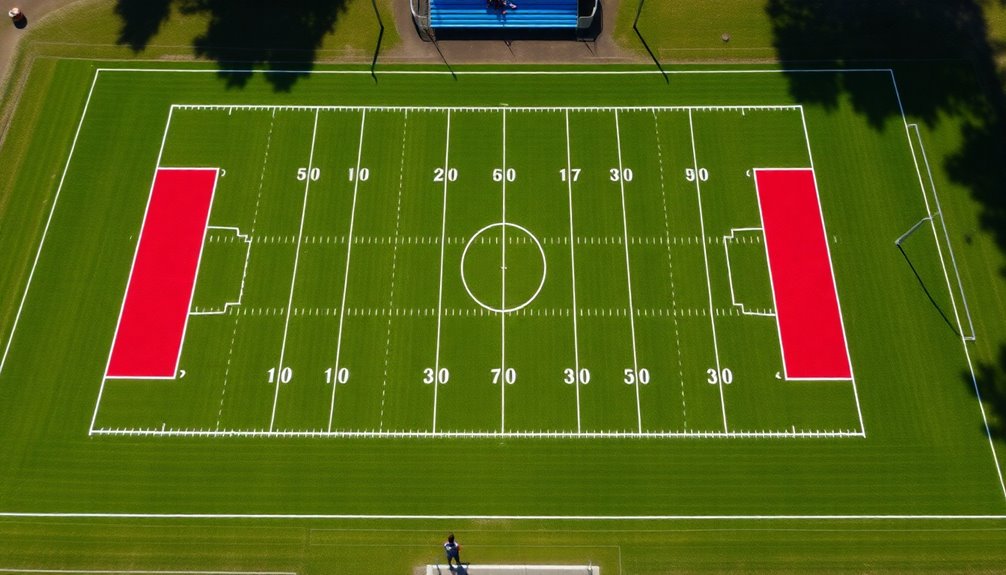
While many might overlook the importance of proper field design, it plays a crucial role in enhancing the overall experience of flag football. When you prioritize the right field dimensions, you're not just creating a space to play; you're promoting fair play and competitiveness.
Here are some benefits of a well-designed field:
- Standardized dimensions (like the typical 30×70 yards) guarantee all teams compete on equal footing.
- Adequate gameplay space allows for strategic plays, including designated no-running zones and end zones.
- Clearly marked lines and safety areas enhance player safety, reducing the risk of injuries and clarifying gameplay boundaries.
- Inclusive designs attract more participants, especially with larger dimensions for girls' flag football leagues.
Accessibility in Field Planning
Accessibility in field planning is vital to guarantee that everyone can enjoy the game of flag football. To foster an inclusive environment, confirm your field has a minimum safety area of 3 yards outside the side and end lines. This extra space helps prevent injuries during gameplay, making the field safer for all participants.
For youth flag football, the recommended dimensions are 30 yards wide and 70 yards long. These measurements accommodate players of varying skill levels while promoting accessibility for everyone involved.
Choosing flat, even terrain is essential for confirming safe movement, especially for those with mobility challenges.
Visibility is another significant factor. By providing clear markings, such as dashed lines for no-running zones, you help everyone understand the football rules and gameplay more easily.
Finally, consider incorporating features like wheelchair-accessible seating and pathways around the field. These additions not only enhance overall accessibility but also encourage broader community participation in flag football, allowing everyone to engage fully in this exciting sport.
Team Size and Field Utilization
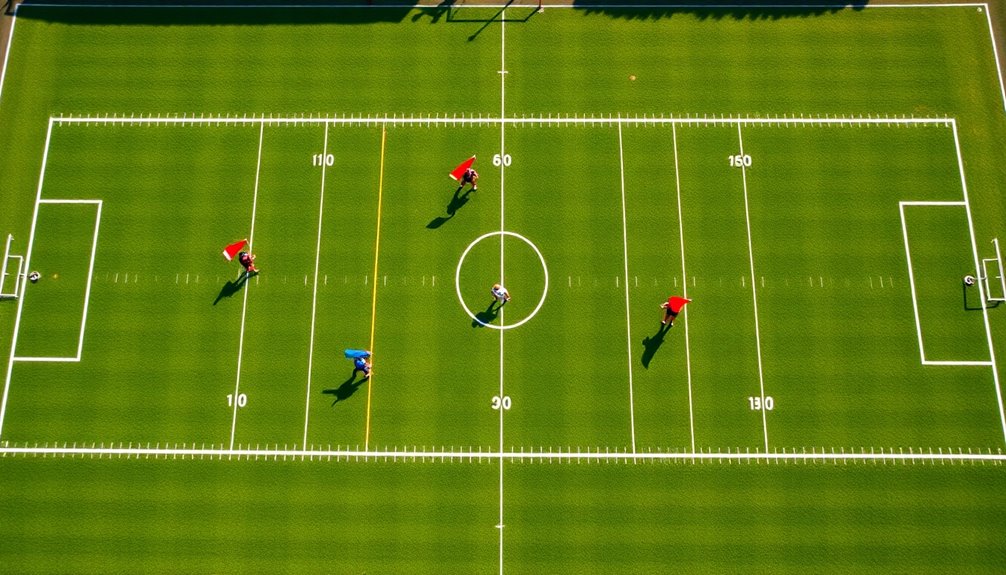
Team size plays a crucial role in how effectively a flag football field is utilized. Typically, teams consist of 5 players, but variations can include 6, 7, or even 9 players, depending on the league's rules. Choosing the right team size influences your strategy and overall gameplay.
When planning your flag football field layout, consider the following:
- Space Management: Smaller teams may benefit from a compact field, usually 25 yards wide and 53 yards long, which can enhance gameplay dynamics.
- Player Dynamics: A larger team can create more complex plays, but it may also lead to congestion on the field.
- Flag Placement: Each player must wear flags, so verify they're easily accessible for opponents to pull during play.
- Field Markings: Adequate field markings, including no-running zones and down indicators, are crucial for clear gameplay and rule compliance.
Weather Considerations for Gameplay
Weather can throw a wrench in your flag football game, affecting not just player performance but also safety. Different weather conditions can create challenges that players must navigate.
For instance, a wet or muddy field increases the risk of slips and falls, which can lead to injuries. Be mindful of the wind, too; it can change the trajectory of passes and kicks, requiring quarterbacks to adjust their throws accordingly.
Extreme temperatures pose another concern. Whether it's scorching hot or frigid cold, players need to stay hydrated and dress appropriately to prevent heat exhaustion or hypothermia. Always monitor the forecast before games.
If thunderstorms roll in, prioritize safety. Evacuate the field immediately, and don't resume play until at least 30 minutes after the last lightning strike.
Visibility is also essential for effective gameplay. Fog or heavy rain can hinder sightlines, making it difficult for players to track the ball and each other.
This can disrupt game dynamics and affect overall performance. By considering these weather-related factors, you can enhance safety and guarantee a smoother game experience for everyone involved.
Enhancing Player Experience Through Design
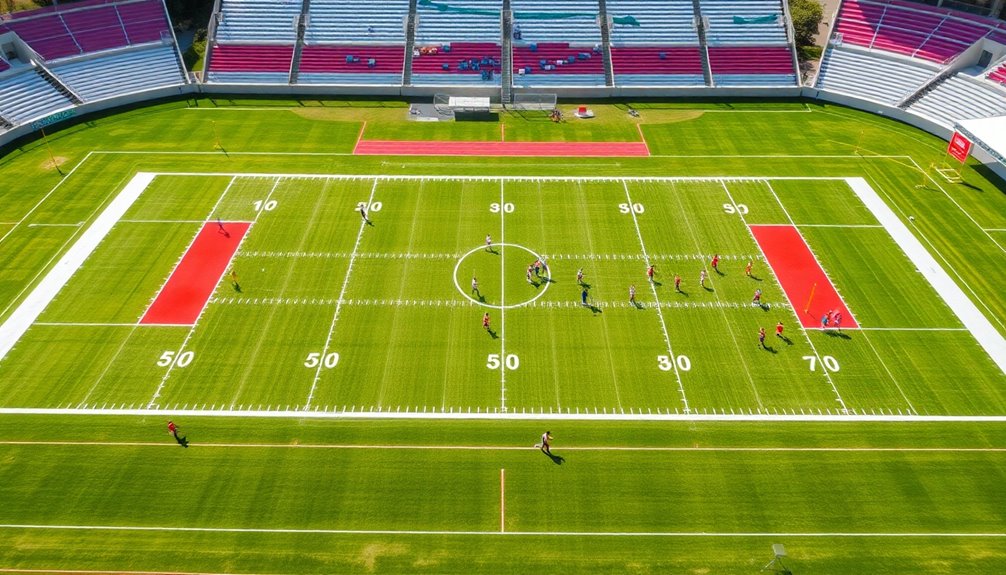
Creating a flag football field that's thoughtfully designed can greatly enhance player experience and performance. By focusing on the right dimensions and layout, you can create an environment that promotes both fun and safety.
Here are some key design elements to contemplate:
- Field Size: A 30×70 yard field with 10-yard end zones provides ample space for gameplay, perfect for youth players and recreational leagues.
- Safety Areas: Including 3-yard buffer zones outside the sideline and end lines minimizes injury risks, giving players room to maneuver during intense plays.
- Clear Markings: Establish no-running zones 5 yards before each goal line for better strategic passing, helping players comprehend gameplay rules.
- Visual Aids: Install pylons at sideline and goal line intersections to enhance scoring visibility, adding excitement for both players and spectators.
Conclusion
In summary, while you might think that strict adherence to flag football field dimensions isn't essential, it actually plays an important role in gameplay and player safety. A well-planned field layout enhances the experience for everyone involved, ensuring fair play and minimizing injuries. By paying attention to dimensions, markings, and accessibility, you create an environment where players can thrive. So, don't overlook these details—they're key to fostering a love for the game and promoting skill development.

